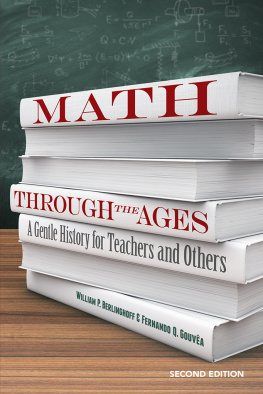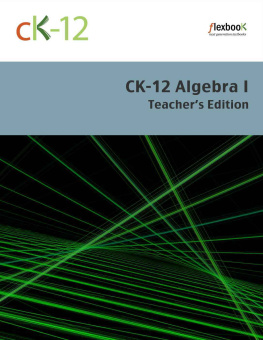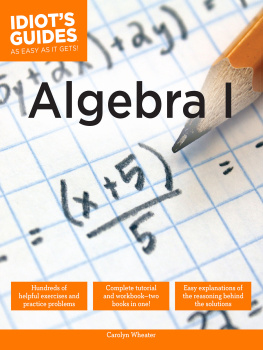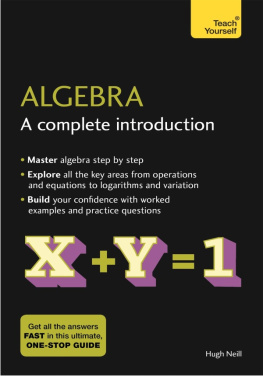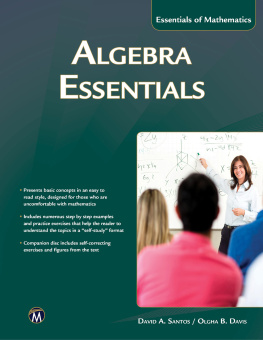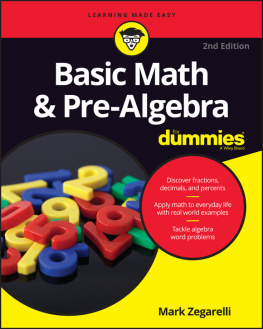MATH
THROUGH THE AGES
MATH
THROUGH THE AGES
A Gentle History for Teachers and Others
Second Edition
William P. Berlinghoff
Fernando Q. Gouva
Colby College
DOVER PUBLICATIONS, INC.
Mineola, New York
Copyright
Copyright 2002, 2014 by William P. Berlinghoff and Fernando Q. Gouva All rights reserved.
Bibliographical Note
This Dover edition, first published in 2019, is an unabridged republication of the second printing of the 2014 second edition of the work, originally published by Oxton House Publishers, Farmington, Maine, in 2002.
Library of Congress Cataloging-in-Publication Data
Names: Berlinghoff, William P., author. | Gouva, Fernando Q. (Fernando Quadros), author.
Title: Math through the ages: a gentle history for teachers and others / William P. Berlinghoff and Fernando Q. Gouva.
Description: Second edition, Dover edition. | Mineola, New York: Dover Publications, Inc., 2019. | Second edition originally published:
Farmington, Maine: Oxton House Publishers, 2014. | Includes bibliographical references and index.
Identifiers: LCCN 2018045098 | ISBN 9780486832845 | ISBN 0486832848
Subjects: LCSH: MathematicsHistory.
Classification: LCC QA21 .B47 2019 | DDC 510.9dc23
LC record available at https://lccn.loc.gov/2018045098
Manufactured in the United States by LSC Communications
83284801 2019
www.doverpublications.com
Preface to the Second Edition
I n the dozen years between the initial appearance of this book and today, two ongoing events have motivated us to prepare this revised edition. The first is the significant expansion of published scholarship in the history of mathematics, including many new books accessible to non-specialists. The second is the gratifying widespread use of this book, both here and abroad, and the continuing demand for it. In addition, several more topics, admittedly chosen by personal taste, seemed to merit sketches of their own.
Five new historical Sketches on the tangent function, logarithms, conic sections, irrational numbers, and the derivative have been added. We opted not to change the numbering of the original Sketches, so the new ones are numbers 2630. Also new is the "When They Lived'' section just before the Bibliography. It replaces all the parenthetical birth/death dates that had appeared somewhat intrusively (and, alas, inconsistently) throughout the text, after the name of each mathematician or other prominent historical figure.
Parts of the "Nutshell" overview have been rewritten extensively to reflect recent scholarship. The "Books You Ought to Read" section and the Bibliography have been thoroughly reworked to reflect recent publications. The index has also been expanded and improved, and the "For a Closer Look" piece at the end of each Sketch has been revised to account for sources that have appeared in the past decade or so.
In preparing this revision we have tried to be mindful of the many college professors whose courses have been built, at least in part, around the first edition. To that end, Sketches 125 have remained substantially the same. To be sure, parts of some have been reworked a bit. In particular, there have been significant adjustments in . Nevertheless, the "story lines" of all the Sketches are unchanged, so they are still compatible with the Questions and Projects of the first Expanded Edition. An Expanded Second Edition with Questions and Projects for the new Sketches is in the works.
Maine, August 2014
Preface to the First Edition
T his book grew out of a few casual hallway conversations in the Colby College Mathematics Department about two years ago. but its roots are much deeper and older than that. For many years we have been interested in the history of mathematics, both for its own sake and as an aid in teaching mathematical concepts to a wide range of audiences. One of us has used it as a major ingredient in several college mathematics texts for liberal arts students and as an important part of his contributions to an NCTM Standards-based high school mathematics series. The other has done considerable background research in the field, has participated in the Mathematical Association of America's Institute for the History of Mathematics and its use in Teaching, and teaches a course in the history of mathematics at Colby. We are convinced that knowing the history of a mathematical concept or technique leads to a deeper, richer understanding of the concept or technique itself.
Unfortunately for teachers and other people with some interest in mathematical history but relatively little time to pursue it, most books on the subject are dauntingly large. If you want some historical background as you prepare to teach quadratic equations or negative numbers, or if you are just curious about the history of or the metric system or zero, where would you look? The indexes of most history books will point you to a disjointed scattering of pages, leaving to you the task of piecing together a coherent picture. A topical search on the Internet is likely to inundate you with information, some reliable, some spurious, with little guidance as to which is which.
We decided to write a book with your needs in mind. The main part of this book is a collection of twenty-five short historical sketches about some common ideas of basic mathematics. These sketches illustrate the origins of an idea, process, or topic, sometimes connecting seemingly distinct things that share common historical roots. They are preceded by a brief panorama of the history of mathematics, from its earliest days to the present. This provides a skeletal framework of important people and events that shaped the mathematics we know today, and it supplies a unifying context for the separate, self-contained sketches. Of course, the choice of sketch topics was quite subjective; we were guided partly by our own interests and partly by our sense of what might interest teachers and students of mathematics. If you would like to suggest a sketch topic for the next edition of this book, we invite you to submit it to Oxton House Publishers, either by mail to the address on the copyright page of this book or by e-mail to one of the authors.
We have made every effort to reflect accurately the historical facts as they are known today. Nevertheless, history is far from an exact science, and incomplete or conflicting sources often lead to conflicting judgments of fact among scholars. Some stories about mathematical people and events have evolved over many years, creating a body of "folklore" with very little hard documentary evidence to support it. Despite their potential to annoy historical scholars, many of these stories like folk tales in every culture are valuable, either as allegories or as mnemonic "hooks'" to help you (or your students) remember a mathematical idea. Rather than ignore such anecdotes entirely and lose their value, we have opted to include some of the more interesting ones, along with appropriate cautions against taking them too literally.
To help you track down more information about any topic that interests you, the section entitled "What to Read Next" is an annotated list for further reading. It includes some pointers to reference works, but its heart is a short "ought-to-read" list of books that we think anyone interested in the history of mathematics probably would enjoy.
A note about notation: In recent years, some history books have been using B.C.E. ("before the common era") and C.E. ("the common era") in place of the more traditional B.C. and A.D., respectively. Depending on which historian one consults, this is either (a) the notation of the future for historical literature, or (b) a passing ''politically correct" fad. Without taking a position on this question, we have opted for the notation that we believe to be more familiar to most of our potential readers.

